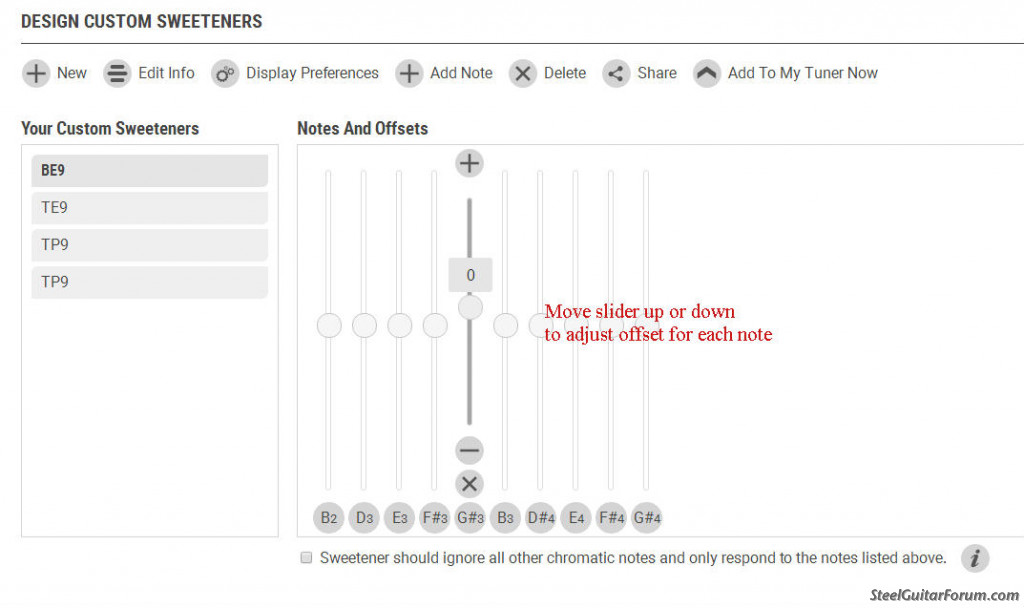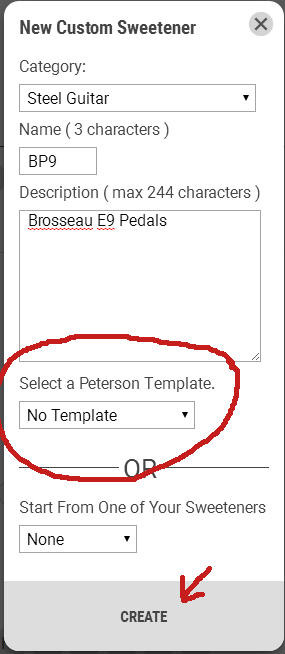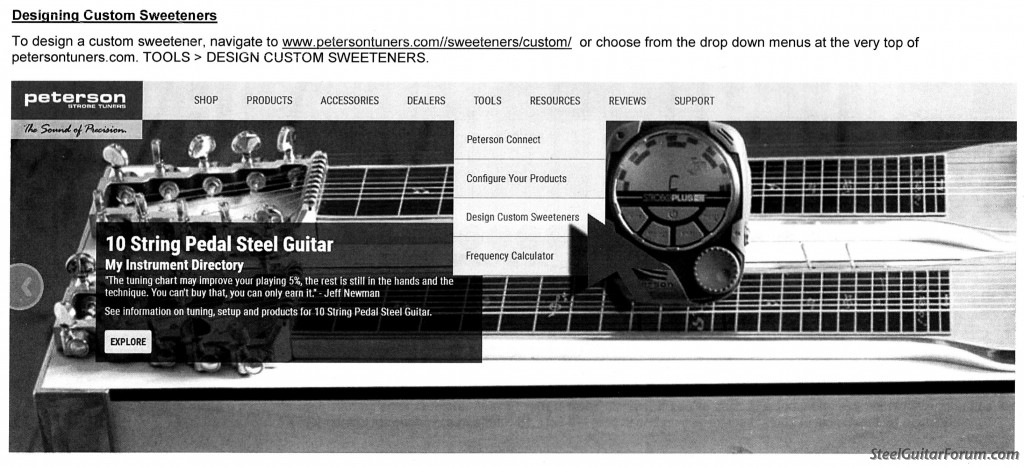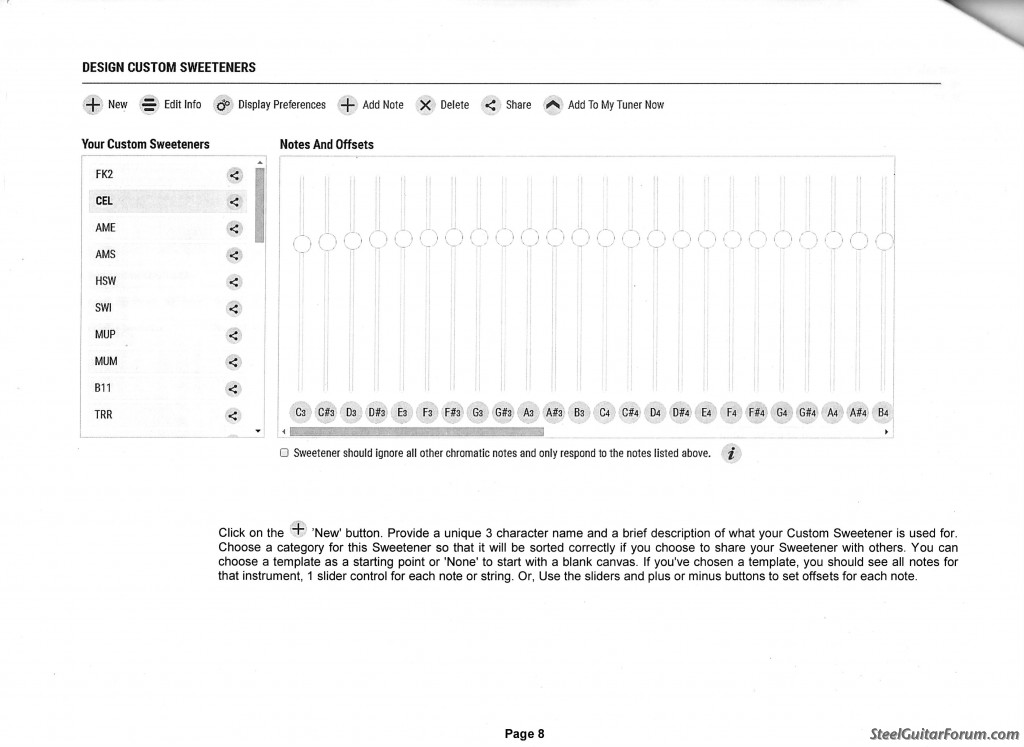Rene Brosseau wrote:A step by step from a fellow steeler would be nice...I have trouble with which octaves to use when dealing with more than 1 F# & G#...some F#s are different than others....none of the sweetened presets work for me
The following assumes that you know the actual offsets you want for each string/note in your personal sweetened tuning. If you haven't figured those out, start by ear-tuning the guitar to your satisfaction. Then use the tuner to determine the offsets:
1. Set the tuner to EQU using the wheel.
2. Click the wheel (3x) until the "cents 0.0" display comes up.
3. Select a string and play it. Rotate the wheel until the strobe display becomes steady. (Clockwise for + offset, counter-clockwise for - offset) The "cents" display will show the offset.
4. Write this offset down and repeat for all other strings as necessary.
Alternately, you can use the phone app PitchLabPro to measure the offsets (actually easier than using the StroboPlusHD)
Now go to the Peterson Connect site to begin the process of designing a custom sweetener using these offsets.
There are a couple of ways you deal with the different F# and G# notes. First, you'll want to set up TWO sweeteners: one for OPEN strings, and the other for PEDALS & LEVERS. That is how the pre-installed pedal steel sweeteners work also.(ex: EM9 is Emmons open strings, EP9 is Emmons pedals)
So you'll start by creating a "+New" sweetener for your OPEN strings. Give it a 3 digit name, for example BE9.

The OPEN string sweetener is straightforward. You have two F#'s and two G#'s, but they are in different octave ranges. Here are the octaves of the open strings in E9 tuning:
String 1 = F#4
Srting 2 = D#4
String 3 = G#4
String 4 = E4
String 5 = B3
String 6 = G#3
String 7 = F#3
String 8 = E3
String 9 = D3
String 10= B2
If you use the
Steel Guitar E9 template as a starting point, those octave numbers are already listed. If you prefer to build the tuning from scratch, you simply specify the octave (3 or 4) when creating the note. Once you've done that, the tuner treats each F# and G# as a separate note, and you can specify different offsets for each. Notice that the notes are listed in
order of pitch from low to high, not the order they occur on the instrument.

When you are done with the OPEN strings, click on "Add To My Tuner Now" to save it. This is the tuning that you'll be using 90% of the time when you tune up your guitar.
Next, you'll create your PEDALS/LEVERS sweetener by clicking "+New" like you did for the open strings. Give it a different name, for example BP9.

In this sweetener, you don't need to add any notes other than the specific ones used on your pedals and levers, so you have a choice of whether to use a template or not. Since you want to distinguish between octaves, select "No Template". This will allow you to enter each pedal offset by octave. For each note you want to add, select "+Add Note". In the dialog box, scroll up or down to select a note in the correct octave. Use the slider to adjust the desired offset.

Here are some of the common pedal and lever ranges:
A = C#3 - C#4
B = A3 - A4
C = C#4 - F#4
E = Eb3 - Eb4
F = F3 - F4
As you can see, with the exception of the low open B2 string, you can assume that for all your changes, the lower strings are in the 3 octave range, and the higher strings are in the 4 range. When you've added all your notes, they will appear just like when you set up your open tuning, so adjustments can be tweaked with the sliders. Like before, save by clicking "Add To My Tuner". To actually add these to your tuner, you have to connect it to your computer and update your configuration.
If you find that you have duplicate notes in the same octave, you can give each of them a different name. The 3rd page of the scan below explains the process. (The paragraph mid-page, next to the graphic)
I'm sure this is something you want to accomplish for yourself, but the website allows us to share sweeteners. If you provide the offsets, I or somebody else could create your sweetened tunings and add it to the shared library for you to download. Just a thought.
Here are scans of a handout Peterson has which describes how to create new sweeteners:



[/img]






 [/img]
[/img]